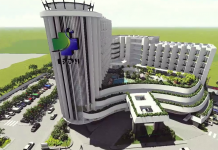80 years — That’s 8 decades, 960 months, 4,174 weeks, 29,220 days, 701,280 hours, 42,076,800 minutes and 2,524,608,000 seconds. — Quoted
****
In Davao City, orchids — particularly waling-waling – bloom. And so do many, many other flowers.
But it’s not only ornamental flowers that bloom. Even the flowers of fruits bloom anytime of the year. Name it, Davao City has it: durian, mangosteen, pomelo, mango, papaya, guava, lanzones, rambutan, and yes, banana. Not to be forgotten are the flowers of coffee and cacao.
On March 16, Davao City will turn 80. Yes, it has been eight decades now since Davao became a city. From being a laid back city, it is now a bustling premier city. Many Dabawenyos, so enamored with this city, cannot help but call it the current “center of the universe,” on account of the fact that it has recently produced a President of the Republic.. its former mayor Rodrigo R. Duterte.
From being tagged as Asia’s “murder city” largely by political detractors, it is now one of the safest cities in the region, if not the world.
This year’s celebration theme is: “Stand Tall. United. Resilient.”
“Our celebration is a celebration of our unity as a people — united in the face of challenges and adversities and determination to survive and overcome every trial that comes our way,” explained Mayor Inday Sara Duterte-Carpio.
Today, Davao City does not only bloom; it also booms. Take the case of its population. Based on the 2015 Census done by the Philippine Statistics Authority, Davao City will soon hit the 1.9-million population mark. That’s 300,000 more people added to the population reported in 2010.
The population may swell to 2 million as more people from nearby provinces and other parts of the country migrate to the country’s largest city in land area.
A few years back, the City Mayors Foundation ranked Davao as the 87th fastest growing city in the world, and it has been listed by the United Kingdom-based Foreign Direct Investment (FDI) Magazine as the 10th “Asian City of the Future” together with two other Philippine cities – Quezon City (ranked 7th) and Cebu City (8th place).
Davao City serves as the regional center for the Davao Region (which is composed of the provinces of Davao del Sur, Davao del Norte, Davao Oriental, Compostela Valley and Davao Occidental).
“The increase in population was the result of migration, among others, of people from other regions because Davao City offers many opportunities as a hub of government, business, and industries,” observed the Philippine Statistical Authority.
In the Philippines, most of the largest cities — Metro Manila in Luzon, Cebu in the Visayas, and Davao in Mindanao — are considered as the economic engines of the country. Davao City, for instance, is on the verge of turning into a bustling metropolis and with the influx of foreign and local business investors, the numbers are on its side.
Despite of the proliferation of top companies operating in the city, Davao is pictured as one of the best places in the country where oldies can retire.
Zipporah Antonio, who works as a content writer of Housing Interactive, Inc., wrote:
“Modern meets the old. Indeed, this dynamic province is a perfect marriage of traditional culture and cosmopolitan living. It may have the usual hustle and bustle of city life, but it is able to retain that ‘small town’ feel. Signs of Davao’s progress and success are seen through the rise of developments throughout the area. This is mainly to accommodate the burgeoning number of expat and local communities.”
Antonio further wrote: “Its rich history, picturesque landscapes, breathtaking islands, exciting water-related activities, and remarkable tourist destinations are few of the main reasons that make the province an interesting place for retirement. Likewise, the cost of living is definitely more affordable than Metro Manila and Cebu.”
In 2006, Davao City hosted the tourism forum of the members of the Association of Southeast Asian Nations. “Davao is slow compared to Hong Kong, Bangkok, Manila, and Cebu,” wrote Ernie Abella, editor of Madayaw, a magazine that was released in conjunction with the event. “But you can get from sea to mountain by the time you finish the juice of a fresh coconut.”
There are several reasons why Davao is now one of the tourist destinations in the country. In a website called toptens.com, people give some reasons on why the city is such a good place to visit:
“With its unique emergency response system, you can call 911 in whatever situation you are in. The city is known for its tight security and strict implementation of the law,” wrote one visitor. “It is also known to be the ‘fruit basket of the Philippines;’ from the exotic durian and mangosteen to one of the most exported product of the Philippines, banana, you will find all of them here.”
Another one commented: “Davao City is one of the most livable cities in Asia. It has a very low percentage of crime. It is not only typhoon-free but so far has not been visited by a huge typhoon or any great disaster. But one this is sure: Davao City has very delicious and very cold clean water.”
If there are good news, there are also bad news. Take the case of sea-level rise, a direct result of climate change, which may wreak havoc within the city. The Business Risk Assessment and the Management of Climate Change Impacts,” published by the World Wide Fund for Nature (WWF) and Bank of the Philippine Islands (BPI), said the most likely to be affected are the city’s seaports.
“Located along the relatively shallow channel between the city and Samal Island, these port facilities are a nerve center for Davao City’s economy, and serve a variety of ships handling both cargo and passengers,” the risk assessment said.
Another problem the city needs to address is water. Davao has traditionally tapped groundwater as its main water source, the WWF/BPI report said. “It prides itself in the relatively high quality of its drinking water. However, salt intrusion has already been reported in city districts to shore, especially in portions of the city where groundwater extraction continues. Sea-level rise may aggravate this situation.”
But despite all these problems, Davao City has gone a long, long way.




